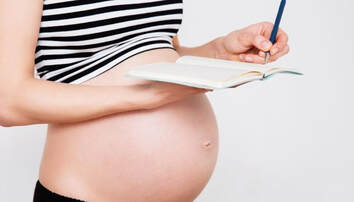|
Why it is important to monitor your baby's movements? What to look out for and most importantly what to do if they slow down or stop. Did you know a decrease in baby's movements can be a key warning sign that a baby is in distress and 50% of mothers who had a stillbirth noticed slowing down of baby's movements beforehand? So read on and find out how to monitor your baby's movements and what to do when their pattern of movements/kicks changes. From around 16 - 24 weeks you begin to feel your baby as they move around in the womb and have a good understanding for how much they "kick", when and where. Your baby's movements are a reassuring sign that they are well if you notice a change then trust your instincts don't delay and get yourself checked out by your midwife or gynaecologist. What’s normal? Most people usually start to feel their baby move between 16 and 24 weeks of pregnancy. You may feel your baby move as early as 16 weeks of pregnancy, especially if you’ve been pregnant before. If this is your first pregnancy, you may not notice your baby’s movements until you are more than 20 weeks pregnant. What does baby movement feel like? A baby’s movements can be anything from a kick, flutter, punch, swish or roll. The type of movement may change as your pregnancy progresses. Baby movement is often referred to as ‘baby kicks’ How often should my baby move? All babies are different! There is no set number of normal movements. From 16 – 24 weeks on you should feel your baby move more and more until 32 weeks. After 32 weeks, movements should stay roughly the same until you give birth. It’s important to get to know your baby’s regular pattern of movement. Why are my baby’s movements important? Your baby’s movements are a sign of their well-being. A reduction or change in your baby’s movements can sometimes be a warning sign that they’re unwell. It’s important to know that it’s NOT true that babies move less towards the end of pregnancy. You should continue to feel your baby move right up to the time you go into labour and whilst you are in labour too. Why would my baby’s movement reduce? When the baby is being deprived of oxygen they will slow their movements to conserve oxygen. Cord compression, a failing placenta, or a high intake of smoke may all lead to reduced movements and could be potentially fatal. What should I do if I notice reduced movement? If you think your baby’s movements have slowed down or stopped, contact your midwife, gynaecolgist or maternity unit immediately. Midwives and doctors are there to help you 24 hours a day, 7 days a week. Don’t put off calling until the next day or wait until your next scheduled appointment. Don’t worry about picking up the phone, it’s important for your doctors and midwives to know if your baby’s movements have slowed down or stopped. What if my baby’s movements are reduced again? You should contact your maternity unit again, however many times it happens. Even if everything was normal last time, don’t hesitate to contact your midwife or maternity unit for advice. You’re always doing the right thing. don’t ignore your instincts, don’t ever put off getting movements checked and make sure you’re aware of any changes in movements as it could quite literally save your baby’s life Why are my baby’s movements important? Your baby's movements are a sign of their wellbeing. A reduction or change in your baby’s movements can sometimes be a warning sign that they're unwell. It's important to know that:
If my baby's movements change does it mean my baby is definitely unwell? Not at all. Checks by medical professionals usually find that everything is OK. Most women who report one or less episodes of reduced movement go on to have a healthy baby and straightforward pregnancy. However, it's important to be checked to make sure the change isn't because your baby is one of the few that are unwell. Reporting concerns about your baby's movements could save their life. Should I prompt my baby to move? As it can cause a delay in getting medical advice, trying to make your baby move isn't recommended. If your baby's movements are concerning you, always call your maternity unit/midwife or gynaecologist. Should I use a phone app or home doppler to check the baby's heartbeat? Please don't use any device to check your baby's heartbeat, especially if you're concerned about their wellbeing. Even if you think you're listening to their heartbeat, it's possible you're actually listening to your own. The presence of a heartbeat alone does not mean your baby is well too- you both need to be checked by a healthcare professional if you're worried. Kicks Count aims to reduce the UK's high stillbirth and neonatal death rate by raising awareness of baby movements. You can find more out about Kicks Count here Adapted from the Kicks Count website (Jan 2023)
0 Comments
Following from my blog post FRONT AND CENTRE IS WHERE YOU NEED TO BE -WRITING YOUR BIRTH PROPOSAL read on the find out more about how to write your birth proposal. Midway through your pregnancy it is an idea to discuss your birth plan with your midwife or gynaecologist. It is a way of registering your preferences for the process of your labour so that your wishes can be carried out whilst you concentrate on relaxing, breathing and focusing on the birth of your baby. The ethos of hypnobirthing is to encourage natural childbirth and empower you to be in control of this process. Here are a few areas for you to discuss with your midwife and add to your birth plan if you wish. In a hypnobirthing course these are covered in more detail but please feel free to drop me an email or call if you want to discuss any of these areas. Your Environment A quiet and calm environment where you feel safe and confident will help keep you relaxed and let your labour develop quickly and smoothly. It is easier to create this environment in your own home but points to consider include:
Natural Birth If you plan on taking a course and practising for a Hypnobirthing Birth it is a good idea to let your caregivers know this so they can be fully supportive. Whilst Hypnobirthing is becoming more widespread there are still a number of health professionals who have not had any experience of the process. Simply put, practising hypnobirthing empowers you to have a calm and gentle, natural and drug free birth, and uses self hypnosis, breathing, and deep relaxation and visualisation techniques. It is best if you request patience and understanding to refrain (in the absence of medical emergency) from any intervention, or any procedure that could unnecessarily stand in the way of you having the most natural birth possible. It is good to state this clearly on your birth plan/proposal. Activity During Labour Although gentle movement can be beneficial in the early stages of labour, please bear in mind that you need to conserve your energy for actual birth of your baby. Eating whatever snacks appeal to you in the early stages of labour helps to maintain your energy. Remember the muscles of the uterus are some of the strongest muscles in the human body and they are working to capacity. Labour can be entirely comfortable and, at the same time, the muscular effort is powerful. Vaginal Examinations If you prefer to be undisturbed, you can decline an internal examination with no risk to yourself or your baby in normal circumstances. Monitoring Your Babies Heart Your baby’s heart can be monitored by Doppler ultrasound or with a stethoscope if you prefer not to expose your baby to the risks of sonar. Positions to Give Birth In There are a variety of positions you can give birth in but ultimately you’ll do what you feel like at the time. Many women find that a vertical, slightly forward position is the most comfortable, so that the weight of the baby is not pressing on your circulatory and nervous systems, gravity is on your side, and the capacity of the pelvis is at its maximum. Popular positions include:
Birthing Pool Many women find having a bath or shower very comfortable in pregnancy, and this feeling of relaxation in water can continue in labour. Being relaxed and at ease in the water allows your muscles to work more freely and so your baby is born more quickly. A birth pool is warm and you’re buoyant so you can move more easily into any position that suits you. Being in the water also increases the chance of respectful care, and women say it improves their experience. Birth pools were pioneered by Michel Odent in the 1970s on the grounds that a baby had been in ‘water’ for the last nine months and so would find it a more gentle introduction to the world. Skin to Skin Contact with Your Baby Immediately after your baby is delivered they can be placed on your tummy, giving skin to skin contact. This is very beneficial because the only things in your baby’s new world that it recognises from it’s old world are your skin, your heartbeat and breathing, and you and your partners voices. Skin to skin contact helps to build the bond between you and your baby and helps establish breastfeeding. You should allow any vernix to be absorbed into your baby’s skin so there is no need for any cleaning or rubbing. It can be done later if needed with a soft cloth. Delivery of Your Placenta In hospital directly after the birth you will often be offered an injection of artificial oxytocin. The purpose of this is to cause uterine contractions and to prevent or stop postpartum haemorrhaging and help with a fast delivery of the placenta. However evidence shows this may be an unnecessary procedure in many women and may inhibit the production of natural oxytocin. It is often routinely being used without full knowledge of the mother. The choice is yours, and it is wise to do some research beforehand. This is one of the many subjects which are discussed in a hypnobirthing course. A drug free and natural way for your body to achieve the same process as above is to immediately breastfeed your baby which will assist with the natural delivery of your placenta, as well as give your child the sustenance and comfort it needs at the beginning of life. Special Requests A few other ideas you might like to consider:
Vitamin K for your baby Vitamin K is offered for babies and again the choice is yours. It can be given by injection after they are born and helps prevent a rare disease called Vitamin K Deficiency Bleeding. It can be also be given by mouth in several doses after your baby is born which saves them from an injection within the first few hours of arriving in this world. If you choose to give the vitamin K by mouth it is essential that it is completed in full. Of course you can choose not to give Vitamin K. Cutting your Baby's Umbilical Cord Delaying the cutting of the cord until it has stopped pulsating enables the full supply of oxygenated blood to reach your baby. This also provides a dual support system while your baby learns to take its first breaths. Breastfeeding Supporting and encouraging you to breastfeed several times during the first few hours after birth. It’s a wonderful way of establishing your bond with your baby. Medical Intervention Medical Interventions can be life-savers in an emergency situation, and unnecessary interventions can themselves create unnecessary problems; something to be considered carefully and researched in advance. Medical interventions are discussed in detail on a KG Hypnobirthing course. You might want to check the AIMS website: www.aims.org.uk/ for more information. Pain Relief There are a number of different pain relief options and many women use a combination of them. To enjoy a natural and comfortable birth, a hypnobirthing course will go a long way to helping you have a calm and gentle birth. Thank goodness pain relief is available, but many hypnobirthing mothers find it is not needed as birth can be comfortable and calm. Induction of Labour Induction of labour is often offered as standard, and often presented as if you have no choice. Remember you are entitled to a full discussion and explanation of the pros and cons before you decided on any intervention. Always listen carefully to medical advice; your midwives and doctor are knowledgeable and experienced, but remember that it is ultimately your decision. On the KGH website you will find a free interactive birth plan you can complete to discuss with your caregivers. I will be discuss many of these topics in more depth on my hypnobirthing courses. But, I hope this has given you some food for thought at this exciting time.
When you're expecting your first baby, it's easy to feel overwhelmed figuring out what baby items you 'need' to buy. This is a fab article from www.thevillage.be/baby-essentials/ They have put together some tips to help you choose your baby essentials, as well as lots of suggestions for how to make your money go further when sourcing baby gear! In fact www.thevillage.be/ is a brilliant resource to delve into it you need any information on having a baby or raising a young family as an ex-pat in Belgium. Navigating the system is not always easy or straightforward and the village covers everything!
A positive birth experience has hugely beneficial effects on you for the rest of your life. It can increase your self-esteem and self-efficacy, mean better acceptance of your role as a mother and strengthens your bond with your baby. Your recollection of your birth experience as either positive or negative, hangs on how in control you felt and the choices you made. So, it pays to be prepared! “a woman's positive and negative recollections of their birth experiences are related more to feelings and exertion of choice and control than to specific details of the birth experience.” (Cook and Loomis 2014) The key to achieving a positive birth experience is to remain at the centre of your birth experience and to be well supported in making the necessary decisions that are right for you and for your baby. But, how do you achieve that? What do you need to do to place you "front and centre"? Firstly, educate yourself Taking a prenatal course is the first step in putting yourself front and centre of your birth experience. A birthing class can help you feel confident in your ability to communicate effectively with your caregivers, feel comfortable asking questions and advocating for the care you want. It is important to understand the physiology of childbirth, the complex interplay of your hormones in labour and how your body is perfectly designed to birth your baby. Being at the centre of your birth experience fits perfectly with the ethos of KG Hypnobirthing, which is to encourage natural childbirth and empower you to be in control. Taking a KG Hypnobirthing course provides a safe space for you and your birth partner to explore what's available to you in pregnancy, birth and on into the early days of parenting. We explore information and practical tools that support you to make informed decisions and communicate more confidently with your caregivers. Secondly, create a birth proposal Once you know the birth choices available to you and understand the physiology of childbirth you can move on to preparing a birth proposal. The process of writing your birth proposal encourages you to answer the questions of "what's important to me?" and "what are my choices and alternatives?". With the resources provided by a KG Hypnobirthing Course you are better able to define your preferences, understand your individual needs and make your birth proposal - a proposal that is founded on information and facts rather than fear and assumptions. Using the word proposal rather than plan acknowledges birth doesn't always go the way you hope or expect expect and leaves space for adaptation and change. Most women either knowingly or unknowingly have an idea of their preferences and how they would like labour to unfold - their birth plan. By, having that proposal in writing you can share it with your caregivers. It is a way of registering your preferences for the process of your labour. Then your wishes can be carried out whilst you concentrate on relaxing, breathing and focusing on the birth of your baby. Top Tips for Creating Your Birth Proposal
To help you create your birth proposal check out the KGH website where you will find a free interactive birth proposal template. Thirdly, share your birth proposal For you to be at the centre of your birth experience everyone involved in your care needs to be supportive of your preferences. So, once you have created your birth proposal it is important to go through it with your birth partner. This enables them to effectively advocate for you in labour. Then discuss your preferences with your caregivers (midwife or gynaecologist). This gives them the chance to get to know you better and understand your feelings and priorities and provides you the opportunity to ask plenty of questions around your birth. It enables you to find out more about what happens during labour and sets expectations. It also flags up any items that may not be possible or that do not align with their practices or hospital policies. If your caregiver brings up areas of concern, be sure to ask:
After discussing your birth proposal with your caregiver, you should know:
This information helps to provide you with insight on your expectations for birth and whether your caregiver and place of birth is the best choice for your needs. Provide a copy of your birth proposal to be included it in your file (which will be present at your place of birth during your birth). Additionally, be sure to make a couple of copies to take along with you when you go into labour. Upon arrival at your place of birth, give a copy of your birth proposal to the hospital midwives. Your birth plan also serves as a reminder for those on your birth support team, including your partner, friend/family member, and doula. Fourthly, be flexible Sometimes things don’t go according to plan during pregnancy or labour. You need to be flexible and be prepared to do things differently from what you wanted. For example, certain facilities may not be available on the day or there may be complications. You can talk to your caregivers about what could happen in labour and include your preferences in your birth plan, but don’t worry too much about trying to include everything. Your caregivers should involve you (or your birth partner if necessary) in any decisions that need to be made on the day to make sure your baby is delivered safely. Yes, you can change your mind! You can change your mind about your wishes for labour and birth at any time, even during labour if you want to. For example, you may find on the day that you don't want a water birth or that you do want an epidural after all. Check my blog post Ideas to Help with Your Birth Plan/Proposal for more information and ideas for writing your birth proposal. Reference:
The Impact of Choice and Control on Women’s Childbirth Experiences Katie Cook, MA; Colleen Loomis, PhD The Journal of Perinatal Education, 21(3), 158–168, http://dx.doi.org/10.1891/1058-1243.21.3.158 |
Kate EllwoodKG Accredited Hypnobirthing Teacher Archives
February 2024
|








